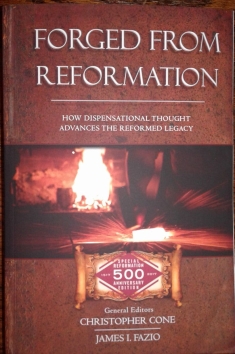 Today I offer the second part of my synopsis of Forged from Reformation. The second section of the book is on “The Five Solas of the Reformation.” I will be focusing on the five chapters covering sola Scriptura.
Today I offer the second part of my synopsis of Forged from Reformation. The second section of the book is on “The Five Solas of the Reformation.” I will be focusing on the five chapters covering sola Scriptura.
Chapter 8: The Protestant Reformation: An Important and Yet Incomplete Hermeneutical Reformation by Dr. Andy Woods.This chapter overlapped to some degree with prior content and in fact covered material that will be familiar to dispensationalists. It does though give a good summary of the way that the Reformers failed to apply their new hermeneutics to the areas of eschatology and ecclesiology. I would espeically recommend and desire that covenant theologians read it to understand where dispensationalism is coming from!
Chapter 9: The Protestant Hermeneutic and the Revival of Futurism by Dr. Ron J. Bigalke. This chapter is a very interesting historical essay about In a word, it seeks to demonstrate the complex connections found through church history between the two related areas of the when of prophecy’s fulfillment (preterism, historicism, idealism, and futurism) and the timing of Jesus’ return with respect to the Millennium (amillennialism, postmillenialism, and premillennialism). The essay is very helpful in giving a comprehensive overview of how we got to where we are now, and clarifies why today’s categories of futuristic premillennialism and preterist or idealist amillennialism are not to be superimposed on historical figures. The author, for example, concludes that many early church fathers were imminent intratribulational premillennialists, believing they were in the era of prophetic fulfillment in a historicist model while still believing the return of Christ was imminent. The main point of the chapter seems to be a recognition that since eschatology wasn’t the main issue in the Reformation, the topic was left to later dispensationalists to develop a Biblical eschatology.
Chapter 10: Sola Scriptura: Return to Literal Grammatical-Historical Hermeneutics by Dr. Thomas S. Baurain.The third chapter was a short, but excellent exposition of the proper hermeneutical system that happens to be espoused by dispensationalists, and I can especially recommend it to almost anyone for its clarity and simplicity in presenting the topic.
Chapter 11: The Hermeneutical Foundations of Sola Scriptua: A Critical Examinatino of Luther’s Christocentric Method of Interpretation” by Dr. James I. Fazio. This chapter was a good summary of the primary ideas of interpretation that lie behind sola Scriptura. The author helpfully tied together many important ideas such as the role of reason in interpreting the Bible, the sufficiency of Scripture, the clarity of Scripture, and more. All this is to lead to a criticism of the principle of Christocentricism in Luther’s thought. It helpfully concludes that one does not violate the preeminence of Christ across Scripture if one does not find Christ in every passage in the way that Christocentricism does.
Chapter 12: Neither Woodenly-Literal Nor Allegorical: The Dispensationalist Legacy of the Refomrers’ Doctrine of Sola Scriptura by Dr. Jeremiah Mutie. While not exactly what I was expecting, this chapter is essentially a historical analysis of four streams of thought from the Reformation–the Reformed, Lutheran, Millerite, and dispensational. These streams of thought are analyzed as it their faithfulness the principle, both in its literal terms and its spiritual intent, of sola Scriptura. Following the preceding chapter by Dr. Fazio, it actually overlaps a bit since they are both ordered around a similar conception of what principles entail sola Scriptura. The analysis of the Reformed and Lutheran streams were somewhat predictible, and good. The Millerite discussion though seemed to not adequately explain how that group was implementing a woodenly-literal hermeneutic to me. But, it did add more information by placing the Millerite group in the stream of historicism that was discussed by Dr. Bigalke in his earlier chapter. I was overall disappointed that the woodenly-literal aspect was not better dealt with in the section, since I tend to move in that hermeneutic direction. But, perhaps it is harder to deal with that topic since fewer groups are comitted to wooden-literalism explicitly. To conclude the chapter, the dispensational stream is placed in a positive light by its faithfulness to sola Scriptura.
The most important three takeaways I have are (1) The important connection that exists between sola Scriptura, the perspicuity of Scripture, and the literal grammatical-historical method of interpretation. (2) The very real reality that the Reformers did affirm both a historicist approach to prophecy and a Christocentric hermeneutic practically. (3) The real need to deal with adequately the subjective element of clarity in interpretation and the objective element of clarity in interpretation. In regards to #3, this found its fullest expression in Dr. Fazio’s chapter on the Christocentric hermeneutic. There, it was clearly explained how Luther delineated the internal clarity that is provided to the true Christian by illumination from the external clarity in the text as written and inspired by God. I follow an approach that focuses the Spirit’s illuminating work as pertaining to receiving the truth interpreted by the literal hermeneutic and not understanding it in the sense of arriving at the meaning of a passage. I’m not certain that Luther is entirely on the same page with me on this, but he was close. I still remain interested in trying to better understand the interplay of the Spirit’s work in my life as I seek to understand the Bible and the following of my rational faculties in seeking the clear meaning of Scripture.
In conclusion, this section was a bit more historically focused than I expected. I confess my need to study further the issues of Scripture’s clarity, the defense of Biblical authority, and the difference between woodenly literal and grammatical-historical. However, this is definitely a section worth reading for me and especially for non-dispensationalists. It does indeed show how dispensationalism is the true advance of the Reformed legacy.